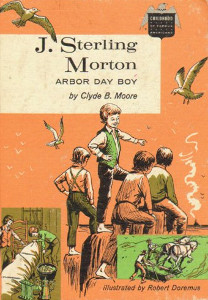J. Sterling Morton: Arbor Day Boy

Author:
Clyde B. Moore
Illustrator:
Robert Doremus
Publication:
1962 by Bobbs-Merrill Company
Genre:
Biography, Non-fiction
Series:
Childhood of Famous Americans (Social and Civic Leaders)
Pages:
200
Current state:
This book has been evaluated and information added. It has not been read and content considerations may not be complete.
Book Guide
Search for this book used on:
"Tell all the fellows the pears are ripe," called young Sterling Morton one late summer morning. He wanted his friends to join him in gathering pears from pear trees near his home. The pear trees were clustered along the banks of Raisin River near Monroe, Michigan.
The Indians once had a village along Lake Erie where Monroe is located today. Later French settlers came and began to build homes and to cultivate the land. The French planted many pear trees, which seemed to grow well in the area. In time the pear trees became part of the woodlands. Sterling loved the pear trees and all other trees near his home.
Besides wandering in the woods, Sterling liked to watch different things happening in the neighborhood. He liked to watch men building a new railroad through Monroe and steamboats coming across Lake Erie.
Sterling's uncle and grandfather published a newspaper in Monroe. Almost every day Sterling stopped to visit them and to watch them work. He liked to listen as they made up new stories and watch them put the stories into type. Often he retold some of the stories to his friends before the stories were published.
Early in life Morton manifested great interest in education. He attended Wesleyan Seminary at Albion, Michigan, and the University of Michigan at Ann Arbor. At the latter institution, he started the first student paper ever published on the campus.
After Morton graduated from college, he moved to Nebraska Territory, where he became a political leader and editor of The Nebraska City News.He took special interest in settling the Territory, and at the age of thirty was appointed acting governor.
Morton was greatly concerned with the development of agriculture and the planting of trees in Nebraska. In 1872 he proposed that a special day, Arbor Day, be set aside in Nebraska for planting trees. More than a million trees were planted the first year.
In 1893, President Grover Cleveland chose Morton as Secretary of Agriculture in his cabinet. By this time Arbor Day was definitely established across the country as a day for planting trees. Each spring Morton himself planted a tree until his death in 1902.
In writing this book, Clyde B. Moore has told a fascinating story about J. Sterling Morton. He shows how this lover of trees translated his love into action by founding an important day for the school children of America.
From the dust jacket
To view an example page please sign in.
Content Guide
Please sign in to access all of the topics associated with this book and view other books with the same topics.
Please sign in to access the locations this book takes place in and view other books in the same location.
Please sign in to access the time periods this book takes place in and view other books in the same time period.
For information about the lead characters please sign in.
Find This Book
Search for this book used on:


